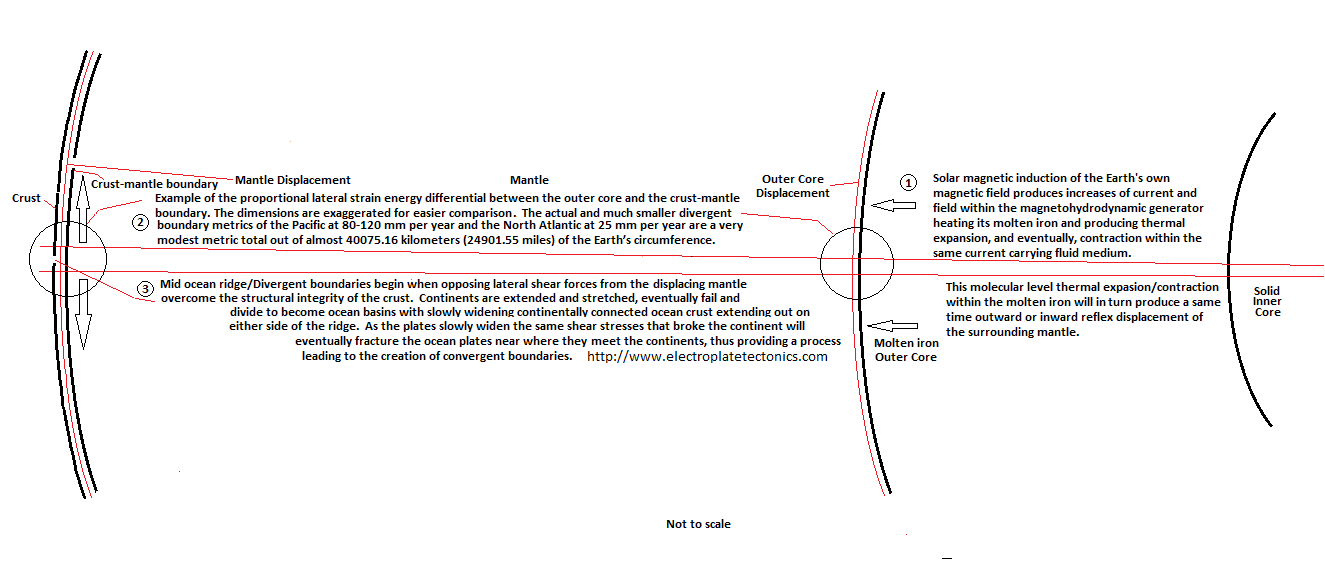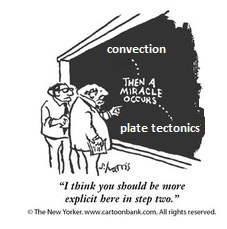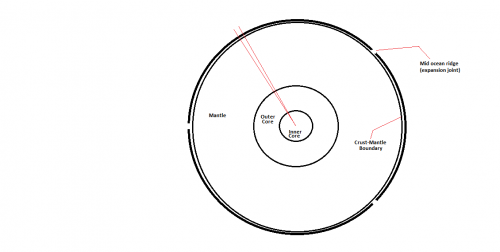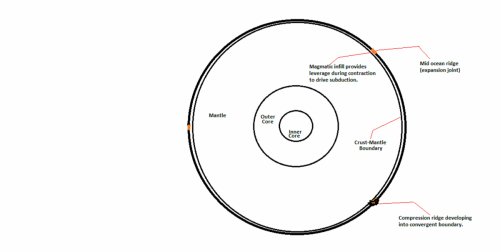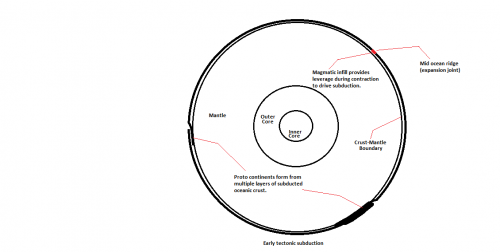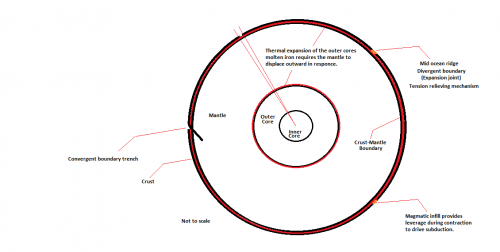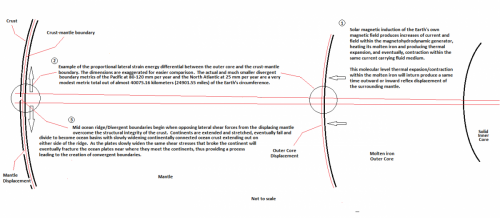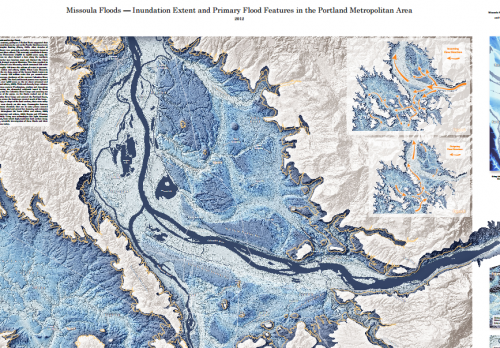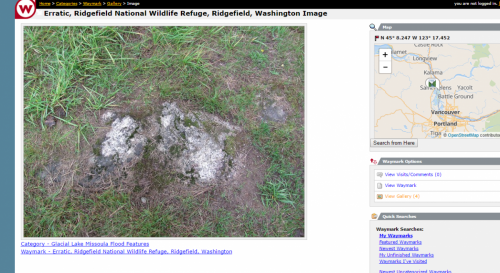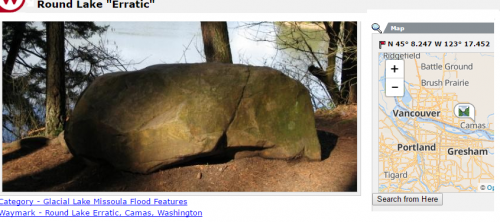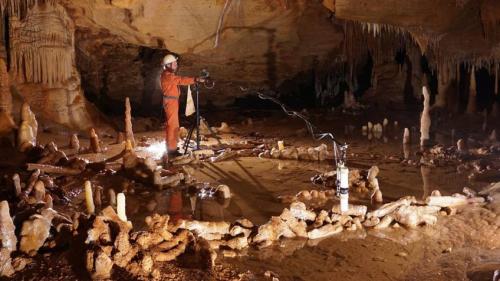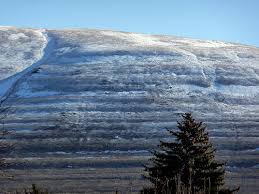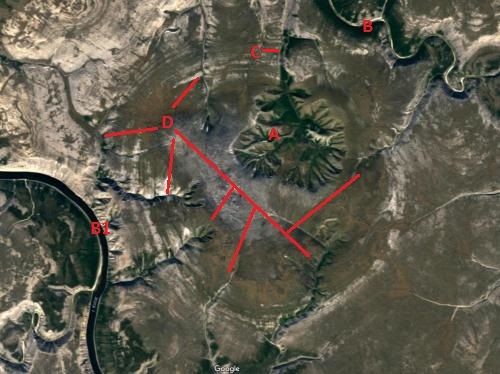-
Posts
978 -
Joined
-
Last visited
Content Type
Profiles
Forums
Events
Everything posted by arc
-
Hello again Argent, Yes I'm sure you are probably right. As I said, your feedback is appreciated.
-
Hello Argent, I'm a little curious as to how many words do you expect this to be. At the bottom of all my posts is a link to my .com web site that has the hypothesis just as you describe above. " in a nicely structured way with the key evidence linked to each step" It is as compact as I can currently make it at the moment due to the "key evidence" involves describing both the mechanics and the predictions of observations that support the overall general outline. Right now it is 214 pages with 51,469 words. This is just the Plate Tectonic part of the hypothesis, the overall "idea" is 370 pages at 97,555 words. It will take me a little while to put something together that I feel is adequate to fulfill the requirement. Your feedback is appreciated. The idea is generally present in those links I had put in that last post. Take a look at this one here, http://www.scienceforums.net/topic/73730-plate-tectonic-mechanism/page-18#entry843598 I will probably begin the summery using it as a template and just add in more details and links. BTW, you refer to "evidence", surprisingly, that detail takes up quite a lot of space and is what ended up making my web page version so long. Evidence requires a detailed explanation. A forum is the worst place to introduce an idea. The OP wants to just tell the story and everyone else just wants to edit it. It's sort of like having a bus with everyone on board having their own steering wheel and gas pedal. It just turns into a wrestling match.
-
I don’t really have a dog in this fight, I could enjoy arguing either position, but I do have an affinity to push the biggest rock. I just wanted to point out a few things that I feel are relevant here. The first one is the guy is no dummy. The second is he has competed against some of the toughest people in his chosen field of battle and has been measurably successful at it. I believe it’s no coincidence that his behavior in both business and politics so far looks to be taken from The Art of War. https://en.wikipedia.org/wiki/The_Art_of_War He seems asymmetrical in his business history or politics. In other words; he appears unpredictable, maybe even crazy to some. I believe this is no accident, the whole “he’s crazy” “he’s a big fat liar” line of describing him is one dimensional and seems not only rather wrong in many ways, it’s kind of humorous. It’s mostly only usable by his opponents to be spooned to their followers, foreign or domestic. A lie is told for a certain strategic advantage. The moral component can be set aside for terrorist and foreign enemies. The domestic consumer should understand the difference, and in regards to domestic politics, it’s always been a liar’s game for the win. Any outrage about it appears to many like me as naive or even politically motivated. Right now everyone who considers him their opponent, whether it is political or militant considers him highly unreadable. In The Art of War this is one of the primary tenants or goals. I have a rather high opinion of Obama as a person, really an honest, stand-up person in my opinion, but completely predictable to his/our opponents. Something that The Art of War BTW teaches you to avoid. The terrorist, N. Korea, China and Russia unfortunately appear to not have worried very much about Obama, or even Bush or Clinton in many respects, for that matter. Remember the phrase “The enemy of my enemy is my friend”, it is likely Trump has been operating by this his whole professional career; I would assume it is at play right now in every conceivable way.
-
Welcome to the suicide squad.
-
Argent, this will have to do at the moment. These outline the model as it was at the beginning in 2012-13. There has been improvements since. Post #1 http://www.scienceforums.net/topic/73730-plate-tectonic-mechanism/#entry735239 Post #4 http://www.scienceforums.net/topic/73730-plate-tectonic-mechanism/#entry735438 Post #5 http://www.scienceforums.net/topic/73730-plate-tectonic-mechanism/#entry735622 Post #6 http://www.scienceforums.net/topic/73730-plate-tectonic-mechanism/#entry735753 Post #7 http://www.scienceforums.net/topic/73730-plate-tectonic-mechanism/#entry735919 Post #8 http://www.scienceforums.net/topic/73730-plate-tectonic-mechanism/#entry735989 Post #9 http://www.scienceforums.net/topic/73730-plate-tectonic-mechanism/#entry736253 Post #10 http://www.scienceforums.net/topic/73730-plate-tectonic-mechanism/#entry736447 These posts below outline how this model's mechanism produces the dramatic differences between the Atlantic mid-ocean ridge and all other ridges around the world. And also, the Atlantic ridge's position within a world wide periodic mountain building regime. Post 422 shows the full application with several direct and rigorous predictions of observations. Post #377http://www.scienceforums.net/topic/73730-plate-tectonic-mechanism/page-19#entry850845 Post #388 http://www.scienceforums.net/topic/73730-plate-tectonic-mechanism/page-20#entry852466 Post #399 http://www.scienceforums.net/topic/73730-plate-tectonic-mechanism/page-20#entry852923 Post #419 http://www.scienceforums.net/topic/73730-plate-tectonic-mechanism/page-21#entry856500 This post is a great predictor of plate movement in general and more specifically for the Atlantic MOR. Post #422 http://www.scienceforums.net/topic/73730-plate-tectonic-mechanism/page-22#entry891454 This post below further supports #422 with additional predictions regarding timing and movement of the Yellowstone complex. Post 426 http://www.scienceforums.net/topic/73730-plate-tectonic-mechanism/page-22#entry900283 This post below is in regards to Solar magnetic proxy data showing a link to Pacific plate movement by way of Japanese earthquake record. Post #348 http://www.scienceforums.net/topic/73730-plate-tectonic-mechanism/page-18#entry815114 The post below (349) is in response to a thread that billiards started on the subduction initiation dilemma facing the standard model and convection; http://www.scienceforums.net/topic/85501-subduction-zones-the-key/page-1#entry826091 Post #349, My model's solution to it ; http://www.scienceforums.net/topic/73730-plate-tectonic-mechanism/page-18#entry843598 Post #474, This is an observation that post #349 predicted over a year earlier before its publication in a journal. Predictions like these are what gives this model advantage over the Standard Model. Post #457, a critique of post #349 by pavelcherepan; http://www.scienceforums.net/topic/73730-plate-tectonic-mechanism/page-23#entry902258 Post #459, is a rebuttal; http://www.scienceforums.net/topic/73730-plate-tectonic-mechanism/page-23#entry902273 Here's another critique by pavelcherepan, This one is more general, post #466; http://www.scienceforums.net/topic/73730-plate-tectonic-mechanism/page-24#entry902370 And my response to it. Post #470 http://www.scienceforums.net/topic/73730-plate-tectonic-mechanism/page-24#entry903463 Still the same condescending billiards we all know and love. As I've repeatedly said; This thread is about "Plate Tectonic Mechanism?" This means the conversation should only involve mechanisms that can be shown to make predictions of observations of plate movement. Which you have been unable to do for the entire time you have been on this thread. The Doglioni et al paper is your qualifier. That is why I have repeatedly asked you to answer those two questions. 1. How does the material in the mantle convect in regards to Doglioni et al? 2. How are mantle dynamics and plate kinematics linked at the surface in regards to Doglioni et al? And, the third one if you recall was; 3. How does mantle convection produce the required levels of GPE in the crust in regards to Ghosh et al? I have watched you attempt every conceivable method to move the goal post away from this requirement. The last few posts were the most recent, and desperate I might add. To use your own words; "More repetition. You need to cut down on that. It's tiring." Here's your post #479;http://www.scienceforums.net/topic/73730-plate-tectonic-mechanism/page-24#entry981756 Quote: "Take these Doglioni problems you keep coming back to. (Note you have never actually stated yourself what the "Doglioni" problems actually are, only referring readers to a LONG document. A classic and pitiful obfuscation tactic.) Let me have a go at summarising them: (1) We do not precisely know the kinematics of the convection flow patterns inside the mantle; and (2) We do not fully understand how the plate is coupled to these underlying flow patterns (convection). Let's take argument (1) and say your model tells us the flow direction at every point inside the mantle. So what is the flow direction 500 km deep beneath the UK? What is the flow direction 2800 km deep beneath Hawaii? Please answer these questions and if you can't then your model automatically fails "Doglioni test #1". Now let's assume you do give quantitative answers, let's compare your position to the "standard" model. There are plenty of models in the literature that will give you an answer to that question. However, they are just models, and the "problem" Doglioni is talking about is just that: they are only models! We need better observational constraints in order to TEST the models. So how is it possible that your model can improve over the existing models when the observational constraints needed to directly TEST this are missing? You cannot possibly claim this ground over the "standard model". Now let's take point (2). You claim your model can explain the link between the underlying flow and the tectonic plate movement. Well first of all how can you do that if you are not SURE you even know what the underlying flow is? (see point 1) Second of all what IS the lithosphere-asthenosphere boundary? That is a subject of intense scientific debate right now, something I doubt you've even heard of, and certainly something you've never mentioned. Understanding the nature of this boundary is CRITICAL to this question and your model says absolutely ZERO about it. Thirdly, and this really is the killer, your model contains NO PHYSICS. Not only is the physical basis underlying the WHOLE of your model a COMPLETE SHAM, you have NO NUMBERS anywhere to explain how the tectonic plates move in relation to any mantle process whatsoever. So you really cannot claim this ground either." Your back must be killing you from moving the goal post so far away from where it was. I can't wait for your next trick. How about "it's better to have no predictions of plate movement than many predictions of plate movement". That would keep you in the game also, according to your new rules. But let's look at those two points you set out up there; (1) We do not precisely know the kinematics of the convection flow patterns inside the mantle; and (2) We do not fully understand how the plate is coupled to these underlying flow patterns (convection). I figured if I pointed out that you were moving the goal post you would maybe step back and make the correction yourself. But no, you just keep going as if the fact that the goal and requirement here wasn't; Mechanisms that can be shown to provide plate movement through predictions of observations. Quote: "Now let's take point (2). You claim your model can explain the link between the underlying flow and the tectonic plate movement." Bold mine; I did not say "underlying flow", and you know this mechanism is based on a multi million year thermal variable of outer core expansion/contraction that slowly displaces the mantle, that above statement is more of your ridiculous attempts to move the goal post. First you claim I said it and then propose its required to explain some convoluted movement regime that you yourself are mired in. Is this a sign of a pathological tendency on your part. You have seen the predictions of observations this model has made, you can go to them on the list above. http://www.scienceforums.net/topic/73730-plate-tectonic-mechanism/page-18#entry843598 Yet, you just dance around, move goal posts and avoid providing real evidence that convection can produce plate movement. It's very revealing that you refer to it as a trap. So, you feel those two Doglioni et al requirements have you trapped? So that convoluted goal post relocation exercise of yours that I quoted above is your desperate attempt to extricate yourself? Sorry to disappoint you, but you're still "trapped" 1. How does the material in the mantle convect in regards to Doglioni et al? 2. How are mantle dynamics and plate kinematics linked at the surface in regards to Doglioni et al? Nice, you provide links to pay walls. "The Atlantic and Indian ridges are in fact moving apart with respect to Africa, proving not to be fixed both relative to each other and relative to any fixed point in the mantle. This evidence confirms that ocean ridges are decoupled from the underlying mantle." Talk about not being coupled. That looks like more of that optimistic "Goal post moving" of yours. Oh, what the hell, you guys are just being "technically optimistic" It makes it seem so much more possible when you can nudge that goal post over a little, right? You know, while were at it, you never explained the Standard model's solution for how those Mid-Atlantic ridge segments ended up at or near the oceans surface as I explained and showed in post #422 http://www.scienceforums.net/topic/73730-plate-tectonic-mechanism/page-22#entry891454 Maybe we could have you give us an explanation of that whole "synchronous mountain building in both hemispheres" that this model explained so easily in that #422 post. That would be great!
-
That sounds rather hypocritical when one considers the Doglioni et al paper gives an honest evaluation of convection’s failures in regards to the Standard Model. “nor has a unique solution been proposed for how material in the mantle convects” That is pretty blunt and to the point. In other words; No one has developed a solution to make convection more than an almost certain impossibility due to its technical difficulties. Doglioni et al has reset the clock. Geology in regards to convection is back to square one. The Doglioni et al paper has basically taken you back to 1919 when the great Arthur Holmes first theorized the idea. An idea he himself suggested was a “purely speculative” idea. http://www.amnh.org/explore/resource-collections/earth-inside-and-out/arthur-holmes-harnessing-the-mechanics-of-mantle-convection-to-the-theory-of-continental-drift/ It was Holmes, in 1919, who suggested the mechanism: that the continents are carried by flow of the mantle on which they sit, and that the mantle is flowing because it is convecting. Warning that his ideas were “purely speculative,” he suggested that rocks in the interior of the Earth would buoyantly rise toward the surface from deep within the Earth when heated by radioactivity and then sink back down as they cooled and became denser. Arthur Holmes understood at the very start that his idea was totally dependent on evidence being found to support it. Only accurate predictions of observations would work to either support or dismiss his conjecture. So, here we are just short of the hundred year anniversary of his idea and what is the most descriptive, accurate and sobering account on convection’s viability? ". . . . . none of the proposed models of mantle convection can account for the simpler pattern in plate motion we observe at the surface, nor has a unique solution been proposed for how material in the mantle convects. At the moment there is no way to link mantle dynamics and plate kinematics at the surface, considering that the mantle and lithosphere are detached. The Atlantic and Indian ridges are in fact moving apart with respect to Africa, proving not to be fixed both relative to each other and relative to any fixed point in the mantle. This evidence confirms that ocean ridges are decoupled from the underlying mantle." Do you see any predictions of observations in that statement above that supports convection or the argument in favor of it? No, there isn’t any. In fact, just the opposite, it bluntly declares that mantle convection is, as you accused this model of being; Not “even physically feasible in the first place”. Well, what was that about convection? - Quote: “nor has a unique solution been proposed for how material in the mantle convects.” Hmmm. Sounds like Doglioni et al are not going to follow your course and are instead expecting something much closer to reality for an answer. Why do you suppose they would say something so refreshingly honest? Because Doglioni can. He can tell every person in the geoscience community today that convection does not work to explain plate tectonics and they will consider it with the regard due its author. http://www.dst.uniroma1.it/doglioni https://scholar.google.com/citations?user=LBFxf2IAAAAJ&hl=en Carlo Doglioni, Sapienza University, Roma, Italy Geosciences, Geodynamics, Earth sciences, Geophysics, Marine geology All Since 2012 Citations 9431 3874 h-index 53 36 i10-index 135 93 So, Doglioni is one of the preeminent geoscientist on the planet. He’s not some run of the mill geologists. He has ascended the highest position possible for any person in geoscience to attain. He is truly a remarkable scientist. I’m going to step out on a limb here and assume that Holmes himself would have greatly appreciated the candor of the Doglioni et al paper. He was a remarkably humble man and I would venture He would not have attempted to counter argue what is now his conjecture’s obviously troubled situation. It’s interesting that you view almost an entire century of “0” predictions of observations supporting convection as just a “gap” in “scientific knowledge”. What? Really! Posted 31 January 2016 - 11:52 PM http://www.scienceforums.net/topic/73730-plate-tectonic-mechanism/page-24#entry903463 Posted 1 April 2017 http://www.scienceforums.net/topic/73730-plate-tectonic-mechanism/page-24#entry980003 Really? That paragraph was much too “LONG” for you, huh? But, that was not the point of Doglioni et al quote, was it? “At the moment there is no way to link mantle dynamics and plate kinematics at the surface” "Is coupled"? Really? “At the moment there is no way to link mantle dynamics and plate kinematics at the surface, considering that the mantle and lithosphere are detached.” And that is what we like to call a lot of hand waving. Pointlessly comparing similarities between apples to oranges as if they could be. My model has no point of contention for a hypothetical “flow direction at every point inside the mantle.” That is the morass that you and the convection of the Standard Model are bogged down into and that Doglioni et al aims squarely to address. Nice try – no not really. Again you are projecting your model’s problems onto my model. My model has made predictions of observations already. It’s your model that doesn’t work. Think about it. It doesn’t make predictions or even been remotely linked to any “plate kinematics at the surface”. Again, trying to make this mechanism dependent on the same vulnerabilities as convection is. This model’s mechanism does not need or is concerned with mantle flow of any sort to move the tectonic plates. This model outlines the creation and disposition of GPE in the crust to facilitate the tectonic plate movement. Yet, you ignore what Doglioni says about convection. And again, you are projecting your model’s problems onto this one that actually works. Really! Yet it makes accurate predictions of observations! What a paradox! And again, you ignore what Doglioni says about convection. Here’s your problem, I only have to make accurate predictions of observations. It doesn’t matter how or why or whether or not I have mathematics to explain it. If I produce an explanation that is simple enough to be preferred by Occam’s razor and it makes accurate predictions of observations – It wins. If your model is complex, convoluted, has not produced predictions in 98 years and is discounted by one of the most renowned geoscientists alive – you lose. If convection has gone 98 years without results then you have way bigger problems than just this model. Dogioni et al allows me to disregard convection until you or someone else can produce actual evidence that it exists - or in other words – show that it can make some predictions of observations. The Standard Model and convection will need to do better.
-
You are then no different then you were as a child attempting to guess at what was inside a gift box you were not yet allowed to open. But now you may spend the rest of your life contemplating what's inside this other mystery box trying to guess if its empty or not. I would rather spend my time examining those mysteries that the boundaries of science allow us to shake, poke, sniff, scuff, weigh and measure, X-ray, ultrasound, don't forget about carbon date, CAT-scan and chemically analyze to our hearts content. The first one you will need to wait until your dead to open and learn what's inside it or not. That seems to me a waste of time to devote a life to something that by any reasonable estimate you can put off . . . . . . pretty much . . . . . . . indefinitely.
-
I'm not being evasive at all. I'm consistently showing this model's ability to predict the observations discovered. And in turn showing the Standard Model's inability to explain the same evidence. That is all that is needed. What I'm also trying to do is establish a base line of understanding of the current Standard Model's abilities and more importantly your apparent and probable bias in regards to its ability to perform to the degree that your confidence in it seems to portray. Doglioni et al is the touchstone that will tell whether convection is this - "do all" - "does everything" - mechanism that everyone has been told it was since grade school or it has been over relied on due to a lack of viable alternatives. You know those cartoon pictures showing convective cells rising under the plates, diverging in opposite directions and dragging the plates along. Then later they morph the story and tell the students its more of a ridge push/slab pull thing that is the physical representation of convective movement. As you said once "subduction is convection". http://www.scienceforums.net/topic/73730-plate-tectonic-mechanism/page-19#entry846940 "Subduction is contingent on mantle convection. You can't have subduction without convection, because subduction is a type of convection!" That is a pretty bold statement from someone who refuses to address the Doglioni et al paper. Not to mention your own thread outlining the fact that you and the Standard Model are completely at a loss as to how subduction actually initiates. http://www.scienceforums.net/topic/85501-subduction-zones-the-key/ Wait . . . what? You're absolutely sure convection IS subduction but you don't even know how subduction begins. Yet your confidence in convection as a mechanism runs counter to Doglioni et al. So who is wrong here. Doglioni et al's opinion looks to be based on actual evidence while yours looks like a bold presumption base on a institutional bias that is due more on what was assumed to be a lack of evidence of other mechanisms rather than convection's vast and superior abilities to predict plate movement. Bold mine. See, that right there is a deflection tactic. There is a massive jump in tectonic viability between saying there is a passive heat content convecting out of the planet to it robustly driving a planetary wide geologically resurfacing regime. Those subduction boundaries , divergent boundaries and vast mountain building in regards to Ghosh et al. Wouldn't it, instead, make more sense that it was my mechanism that actually allowed convection to operate more effectively. The plates moving are helping to move that heat out instead of it being trapped under a stagnate lid. Doglioni et al and Ghosh et al. supports this idea while at the same time, rather fatally, eliminates convection as a plate moving mechanism. I'm not sure what cartoon you are referring to. Do I really need to repost every one of the examples that I have posted ?
-
You call it a dead horse – I call it convection; That’s strange . . . . . . . I’ve looked the whole thread over, can’t find even one moderator admonishing me for not answering all the criticisms, not even one mod note addressed to me. I don’t think they would have allowed me to get away with that. Are you accusing them of dereliction of their duties? Maybe it’s because you haven’t directly answered to those problems I raised about the Standard Model. I do remember I had insisted several times that you should address those three criticisms of the Standard Model and convection’s inability to actually work. Here they are again; 1. How does the material in the mantle actually convect in regards to Doglioni et al? http://www.dst.uniro...antle_Dynamics_ MANTLE DYNAMICS AND PLATE KINEMATICS Carlo Doglioni, La Sapienza University, Rome, Italy Roberto Sabadini, University of Milan, Italy ". . . . . none of the proposed models of mantle convection can account for the simpler pattern in plate motion we observe at the surface, nor has a unique solution been proposed for how material in the mantle convects. At the moment there is no way to link mantle dynamics and plate kinematics at the surface, considering that the mantle and lithosphere are detached. The Atlantic and Indian ridges are in fact moving apart with respect to Africa, proving not to be fixed both relative to each other and relative to any fixed point in the mantle. This evidence confirms that ocean ridges are decoupled from the underlying mantle." 1. How does the material in the mantle convect in regards to Doglioni et al? 2. How are mantle dynamics and plate kinematics linked at the surface in regards to Doglioni et al? 3. How does mantle convection produce the required levels of GPE in the crust in regards to Ghosh et al?
-
If the final result is not to your satisfaction and you are thinking of replacing the glass. You might try etching the entire surface area with an even acid etching. You may get a surprisingly pleasant result. Years ago we did some work in a new retail storefront where the new wood casement surrounding the area we were working had not been sealed yet. We had used a damp cloth to wipe down the neon sign we installed and inadvertently dripped water on the exposed wood below. The general contractor made quite the scene over the fact that it would leave permanent water stains that would show through the final finish. I waited until he was gone on an errand and wiped down the entire casement with the same damp cloth with an even pressure and speed. By the time he had returned it had dried and looked as good as it did before . . . . . . . I water stained the entire surface.
-
Mirrored time universe big bang! Dammit Moon! You scared the crap out of me!! >>>>>>>>>> dual universe time mirror black hole theory Started by PureGenius , 04 Jul 2013
-
The most important function of a model is to make accurate predictions of observations. Many researchers build models towards solving specific phenomena in a “build to suite” fashion where the problem is known, and through diligent hard work and using all of the resources available, including the investigator’s own experience and education - a creative solution is prescribed. These models, though, are usually dependent on the Standard Model, and reflect a heavy reliance on it to support the solution’s functionality in solving the observed and targeted phenomena. When an alternate to the Standard Model such as this one proposes a solution in the same “build to suite” manner it will need to outperform the accepted Standard Model in providing predictions that extend beyond the current body of known phenomena. That is, the alternate model should, or really, must describe, or predict, in a detailed way a process that has not yet been observed or described, preferably by others, to have occurred in nature. And, also preferably, this discovery should be made at some appreciable time in the future after it was described and predicted by the model. This predictability is the optimum criteria for science. That it not only describes what is currently being observed, but will describe in detail a solution to various phenomena observed at a later date that are currently unknown to the science at hand. This model has offered an alternate solution to many geologic phenomena; http://www.scienceforums.net/topic/73730-plate-tectonic-mechanism/page-22#entry891454 This model has made some very accurate predictions of observations, some in the manner described above, where a substantial lead-time was given between the model’s description of the phenomena and the actual discovery of the predicted observation. http://www.scienceforums.net/topic/73730-plate-tectonic-mechanism/page-18#entry843598 In the post above this model described solutions for and made many predictions of observations of existing phenomena besides directly and completely answering the original problem raised and described by billiards. That post presented a complete, yet compact model of the Earth’s crustal development from plate tectonics’ earliest beginning to the development and formation of current plate dynamics. I now would like to show some research that was received for review June 20, 2016 and approved October 11, 2016. http://www.pnas.org/content/113/47/E7359 Rapid conversion of an oceanic spreading center to a subduction zone inferred from high-precision geochronology Timothy E. Keenan, John Encarnación, Robert Buchwaldt, Dan Fernandez, James Mattinson, Christine Rasoazanamparany, and P. Benjamin Luetkemeyer Significance “Subduction, the process by which tectonic plates sink into the mantle, is a fundamental tectonic process on Earth, yet the question of where and how new subduction zones form remains a matter of debate. In this study, we find that a divergent plate boundary, where two plates move apart, was forcefully and rapidly turned into a convergent boundary where one plate eventually began subducting. This finding is surprising because, although the plate material at a divergent boundary is weak, it is also buoyant and resists subduction. This study suggests that buoyant, but weak, plate material at a divergent boundary can be forced to converge until eventually older and denser plate material enters the nascent subduction zone, which then becomes self-sustaining.” Abstract “Where and how subduction zones initiate is a fundamental tectonic problem, yet there are few well-constrained geologic tests that address the tectonic settings and dynamics of the process. Numerical modeling has shown that oceanic spreading centers are some of the weakest parts of the plate tectonic system [Gurnis M, Hall C, Lavier L (2004) Geochem Geophys Geosys 5:Q07001], but previous studies have not favored them for subduction initiation because of the positive buoyancy of young lithosphere. Instead, other weak zones, such as fracture zones, have been invoked. Because these models differ in terms of the ages of crust that are juxtaposed at the site of subduction initiation, they can be tested by dating the protoliths of metamorphosed oceanic crust that is formed by underthrusting at the beginning of subduction and comparing that age with the age of the overlying lithosphere and the timing of subduction initiation itself. In the western Philippines, we find that oceanic crust was less than ∼1 My old when it was underthrust and metamorphosed at the onset of subduction in Palawan, Philippines, implying forced subduction initiation at a spreading center. This result shows that young and positively buoyant, but weak, lithosphere was the preferred site for subduction nucleation despite the proximity of other potential weak zones with older, denser lithosphere and that plate motion rapidly changed from divergence to convergence.” The above research involves many of the same questions raised by billiards and raises many new ones that strain the Standard Model even further than just the subduction initiation problem posed by billiards. The limitations that the Standard Model imposes on these problems include that subduction and divergent boundaries are considered to be caused by separate phenomena. That oceanic crust must be old and heavy (less buoyant) to subduct, and newer (bouyant) oceanic crust cannot become or even initiate a subduction regime. Divergent boundaries are then assumed to be initiated by continental break-up (Atlantic) and then perpetuated by ridge push and/or slab-pull at the corresponding convergent boundary. The Standard Model is thus left with a “chicken or egg first” quandary. The Atlantic has no convergent boundaries, yet the oceanic crust is connected to the N. American plate that moves without the slab pull of a convergent boundary pulling it. It is in all actuality, driving or being driven over the Pacific plate, this would then require the source to be ridge push at the Atlantic divergent boundary. At some point though it is assumed the Atlantic plate sections will separate from their adjoining continents and develop into convergent boundaries. But wouldn't an outward shear force to the plate from below provide that separation? And wouldn't a following opposing shear force from below change that new divergent boundary into a convergent boundary? Nowhere in the Standard Model are there solutions for the problems posed by billiards or Keenan, et al. Fortunately, this model had described and predicted the exact scenario observed and described by the Keenan, et al paper of October 11, 2016 over a year and a half earlier on 25 December 2014. http://www.scienceforums.net/topic/73730-plate-tectonic-mechanism/page-18#entry843598 This model described in great detail the formation of divergent boundaries that were then converted to convergent boundaries long before Keenan, et al suggested that such a situation could exist. The Standard Model on the other hand is unable to resolve this dichotomy or even the much simpler subduction initiation problem that billiards had posed earlier.
-
Not wanting to derail the thread any further, please move or delete if needed. Several years ago we had a nice gal come in to check out our particular occupation (electrical with additional sub categories of expertise) as a possible career choice. They had her spend the day with one of our apprentices (Eddie) who was about to graduate, or turnout as we call it. When they came back at the end of the day Eddie mentioned that she had a degree in biology. Of course I was delighted that she could end up working with us. We talked a little about her degree and how difficult it was to find work in that field around here, she was married with children and looking at several of the state supervised apprenticeships as a possible career choice. I told her it would be great if she came to work with us, and due to her background, how much I would welcome the possible conversational subject matter. Alas, she never came back. It would have been really great if she had. I'm not much into the typical "sports" conversations that the other guys carry on so much about here. So it would have been a welcome change. A REEEEALY welcomed change!
-
I recently viewed a wonderful documentary on George Westinghouse by Mark Bussler. It really captures the era and the social dynamics between Tesla and his relations with both Westinghouse and Edison. They mention that Edison required all of his employees to sign an agreement to forfeit any claim to their creative work. Westinghouse on the other hand actually helped his employees in securing their rights to their ideas. They mention the discrepancy between the sizable number of patents held by Westinghouse employees as compared to Edison's, and this of course explains rather pointedly why Edison personally held so many more patents than George Westinghouse. I think much of Tesla's cult status relates to his misjudgment of his own abilities. His extraordinary ability to develop and "bench test" designs such as his poly-phase system in his mind before ever building any actual physically examples makes him appear super human. He unfortunately later in life exceeded these extraordinary limits of his mind's abilities without building the resultant, and more important, fully working examples that would have maybe humbled his estimations of these creative abilities. Most of the current woo woo about him relates to these extraordinary imaginary creations of a once very productive and creative mind that had entered its post professional era of simply speculating some rather super extraordinary possibilities.
-
I borrowed this from http://www.mantleplumes.org/index.html :: Quote of the week :: "In 399 B.C. Socrates was accused of introducing new gods and questioning accepted gods. He was sentenced to death by a jury of 500 of his peers. His philosophy did not pass peer review." Don L. Anderson
-
Acme, I look forward to their opinion. I have been thinking a bit about this and have concluded; For your specimen to have gravitated to the surface through granular convection it would have require the sub-straight to be as thoroughly mixed as a container of nuts would be when raising a Brazil nut to the surface. In other words, for that scenario to be true; a former stratified or time layered sub-straight could not exist currently beneath that boulder due to the requirement that the same materials would have to be, according to granular convection, vigorously shaken, resulting in their rotational mixing of lower and upper layer materials together as the specimen was simultaneously moved upwards. Frost heave would have also left a tell tale trail to follow. Since the process of frost heaving stones is a group activity engaging any number of other stones in the same area to some degree, at the very least some other stones that reside there would no doubt have been lifted during the process. A freeze cycle regimen capable of lifting that immense specimen would have little difficulty with smaller varieties. There should be many other rocks of more common dimensions laying about the surface in that area. Field stones that are commonly seen made into the walls that line so many Old World and N.E American rural roads and farm fields attest to these "crops" being elevated continuously to the surface over seasonal periods of time. The lack of any sign of appreciable field stone quantity at the subject site would suggest frost heave is not the agent at work here. This rather temperate region does not attain the lower temperature that those seasonally colder field stone regions do. New England winters we do not have. Interestingly though, the loss of top soil is almost universally observed in modern farming practices, this lends to the probability that many of these smaller drop stones around this area that were excavated by farming equipment in the last century are possibly not only due to frost heave but the fact that the surface is being lowered from soil loss while farming equipment has gradually increased in size and strength, thus they have over the last century gradually increased there till depth. These factors alone have assured for the continuous removal of these stones whether or not the stones themselves were rising from frost heave. Although, as you mentioned, graph B indicates most iceberg erratics reside to the south across the Columbia, the two examples I did furnish shows that the one to the east is completely above ground while the other being to the northwest is just breaking the ground's surface. These appear to reside where they initially landed, carried within their parental iceberg to where it had grounded and melted away. The example to the northwest was no doubt buried by the tremendous amount of silt of the Missoula Floods and the Columbia's changing river coarse as it silted up and overran its older channels. These erratics are most easily and most likely explained as erratics that lie where they dropped out of the melting iceberg and either stayed above grade or were covered over based on the local geologic conditions. Occam's Razor would place your example with all the others, all from the same circumstances that were then mediated by various local geologic conditions. But none very far beyond the ordinary circumstances of the others. In other words: If your example was shaken to the surface than many others should have also done the same.
-
Someone is missing from here. It took me a few minutes to figure it out. Where is ajb? I just checked - he's been gone since Oct, I miss seeing that infinite patience of his chipping away at the . . . . err . . aah . . .problem

- Show previous comments 2 more
-

Ok, I read the thread. Us kids hate it when the grown-ups fight:) Well I hope he comes back soon- I'll just miss him till then.
-

-

I think he was moving job and country of residence so will have had a lot of extra-curricular work going on. Like others I do hope he returns
-
An interesting feature of these flood events (maybe around 40 of them) was the icebergs. From your link; https://en.wikipedia.org/wiki/Missoula_Floods "As the water emerged from the Columbia River gorge, it backed up again at the 1 mile (1.6 km) wide narrows near Kalama, Washington. Some temporary lakes rose to an elevation of more than 400 ft (120 m), flooding the Willamette Valley to Eugene, Oregon and beyond. Iceberg rafted glacial erratics and erosion features are evidence of these events." This map at the site below allows you to zoom in to amazingly close resolution. http://www.oregongeology.org/pubs/ims/IMS-036_print.pdf This is a screen shot of that map I made as an example of the range that the flood water could carry these icebergs that in turn were carrying the erratics. That is the Columbia River with the entire Vancouver metropolitan area within the flood zone that extends to Kalama 47 km to the north. This site below chronicles the location of erratics around this region within the range of the flood carried Icebergs. http://www.waymarking.com/cat/details.aspx?f=1&guid=a4f0434e-37f7-4bf9-b13e-d3d0824b86ea&lat=45.13745&lon=-123.290867&t=6&wo=True&p=2&gid=3&sg=c17d366f-f627-497e-b248-6a40cee476ff&st=2 http://www.waymarking.com/waymarks/WMCT67_Erratic_Ridgefield_National_Wildlife_Refuge_Ridgefield_Washington It is located at the Ridgefield National Wildlife Refuge just north of Vancouver. It looks very similar to Acme's example. Here's another erratic located farther to the east; http://www.waymarking.com/waymarks/WM36CY_Round_Lake_Erratic_Camas_Washington And here's a nice video about the Lower Columbia Floods Chapter; http://iafi.org/local-chapters/lower-columbia-chapter/ They chronicle and educate about the floods around this region. http://iafi.org/grants-getaways-oregons-erratic-rocks/ /
-

Neanderthals Built a Water Reservoir
arc replied to Enthalpy's topic in Evolution, Morphology and Exobiology
Why must we conclude that if this was a Neanderthal construct, or for that matter, built by any others, that it must have been a successful design? The more recent human history (you know, the one we have record of) shows a vast array of trial and error as modus operandi. Why would we assume the Neanderthal would operate any different? That image to me shows a campsite far enough within a cave to ward off the deepest cold of that glacial period. They constructed a campfire to stay warm and slept and ate near their fires. Past experience in other campsites inside and outside of caves showed them that naturally positioned rocks at an appreciable distance around the fire became warmer due to the fire and made occupying, and more importantly, sleeping in the area more enjoyable. This would likely lead them to build such a structure you see in the image. The height is just enough to block the draft that comes in the cave entrance and travels along the floor where they would have lain to sleep. The materials would radiate the expected heat that the other campsite rocks had done in the past while the clay or dirt compacted against it would block that cold air that is drawn inward along the floor by the fire and keep it from going through the openings between the materials of the constructed wall. All was done and worked well until the water started to build up behind the wall, as can be seen in the image. Alas, success meets with failure once again. -
I do not know exactly how far your specimen is from Mt. St. Helens. You did say in your first post it was 5 miles from the Columbia River and also St. Helens was 50 miles (30km) north. This rock could be from any of the Pleistocene glaciations and the earlier glacial episodes may have been very much different in their direction of travel than the more recent due to the amount of volcanic activity that drastically changes the surrounding landscape with each eruption. As you can see St. Helens has been a very active player. So, if the 30km distance you provided is correct or the distance is even double that, the tremendous volume of material that the mountain has laid out around its range of discharge in the past could send in the following glacial periods, glaciers in any number of directions and distances within the stated ranges listed. This would seem the most likely source considering the evidence so far.
-
I would really like to understand how this terrain was shaped from the last glacial period. Was this area just caped with ice and all that we see here is the debris of this process? How did those "towers" of rock survive this period?They look rather delicate to have resisted a mile of ice bearing down on them. My guess would be the huge amounts of ground down rock material filled this whole area and these towers were buried in it to quite a depth.Think sand and powdered rock. As the glaciers melted most of this fine material was transported out through normal erosion processes revealing the still fixed and hardest to move materials that we see now.
-
I had a thread previously on this subject; http://www.scienceforums.net/topic/98478-mysterious-little-rock/#entry944470 And also mentioned this situation is not reliant on the Larentide Ice Sheet to distribute these materials during the last glacial. http://www.scienceforums.net/topic/98478-mysterious-little-rock/#entry943609 "I was not referring to the Laurentide Ice Sheet of the last glaciation period but the Cascade glaciation that occurred during the same time period. There is some good accounts of them by Porter et al. Many of these papers unfortunately are now it seems behind paywalls." A nice study by Porter that is available for free is this paper; https://notendur.hi....QuatSci2004.pdf Quaternary alpine glaciation in Alaska, the Pacific Northwest, Sierra Nevada, and Hawaii Darrell S. Kaufman1, Stephen C. Porter2 and Alan R. Gillespie2 1 Department of Geology, Northern Arizona University, Flagstaff, AZ 86001, USA; Darrell.Kaufman@nau.edu 2 Quaternary Research Center, University of Washington, Seattle, WA 98195, USA; scporter@u.washington.edu, alan@ess.washington.edu "During their greatest Pleistocene advance, alpine glaciers in the Washington Cascade Range and Olympic Mountains terminated as much as 70–80 km from their sources. During the last glaciation, the largest glaciers were only half as long. In the Oregon Cascades, glacier tongues terminated 10–30 km from ice fields that mantled the range crest" The 70-80 km estimate is within range to derive this specimen from Mt. St. Helens. "St. Helens which is ~50 miles(30km) north."
-
Oops, somehow I completely missed imatfaal's entire post. Those rings reminded me of when we were in Montana and saw the ancient shoreline "Bath tub rings" down the sides of the valley that were left by Glacial Lake Missoula. Nice job imatfaal, +1. I withdraw my supposition.
-
I believe what you are seeing in that image is this area looks to be limestone or similar soluble rock and this feature is the result of the underlying limestone slowly subsiding and creating a depression that collected water. https://en.wikipedia.org/wiki/Karst Karst topography is a landscape formed from the dissolution of soluble rocks such as limestone, dolomite, and gypsum. It is characterized by underground drainage systems with sinkholes and caves. What you see as rings surrounding this feature are where waves have left evidence of the changing shoreline of the original lake that had formed in the slowly developing shallow depression as the subterranean limestone subsided. As the ground slowly sank the water's depth and diameter slowly increased until this basin, which is called a Polje, reached an area where the seasonal high water could over top the basin's edge, eroding the terrain and draining to a still lower area. You can see these in the image. Area A is likely the first to over-top the outer edge due to its advanced erosion and substantial size compared to the other smaller erosional features D that all appear to drain assorted regions of the basin to the main branch of the Kotuy river system B1 to the S.W of the basin. Area A's drainage channel C runs to the N.E. into a separate branch B of the Kotuy river and likely emptied the vast majority of the basin's water. https://en.wikipedia.org/wiki/Polje A polje, in geological terminology, is a large, flat-floored depression within karst limestone, whose long axis develops in parallel with major structural trends and can become several miles (tens of kilometers) long. Superficial deposits tend to accumulate along the floor. Drainage may be either by surface watercourses (as an open polje) or by swallow holes (as a closed polje) or ponors. Usually, the ponors cannot transmit entire flood flows, so many poljes become wet-season lakes. The structure of some poljes is related to the geological structure, but others are purely the result of lateral dissolution and planation. The development of poljes is fostered by any blockage in the karst drainage. A polje or karst polje covers the flatbottomed lands of closed basins which may extend over large areas, up to 1,000 km². The flat floor of a polje may consist of bare limestone, of a nonsoluble formation (as with rolling topography), or of soil.
-
It's called a siphon. https://en.wikipedia.org/wiki/Siphon Your device is called a siphon mixer injector that uses the moving water to create a vacuum (lower pressure) in the coolant siphon tube which is at a lower atmospheric pressure then what is in the coolant's reservoir. This lower pressure in the siphon tube is what draws, or more properly, allows the higher atmospheric pressure to force the coolant out of its reservoir and into the stream of passing water at the T fitting.

